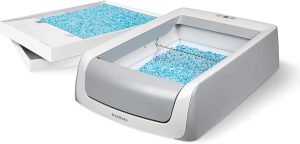If you’ve ever woken up to the unpleasant surprise of a wet spot on your bed, courtesy of your furry feline friend, you’re not alone. Cats peeing on beds is a common issue that frustrates pet owners worldwide. The question, “Why is my cat peeing on my bed?” often leads to a mix of confusion, concern, and a desperate search for solutions. Whether it’s a behavioral issue, a medical problem, or an environmental trigger, addressing this behavior promptly is key to restoring peace in your home—and your bedding.
In this comprehensive guide, we’ll dive into the reasons behind this behavior, offer practical solutions, and review one of the best products on Amazon to help manage your cat’s litter habits: the PetSafe ScoopFree Self-Cleaning Cat Litter Box. With its innovative design and convenience, this litter box could be a game-changer for cat owners dealing with inappropriate urination. We’ll cover its features, pros, cons, and answer frequently asked questions to help you decide if it’s the right fit for your household. Let’s get started!
Why Is My Cat Peeing on My Bed?
Before diving into the product review, it’s essential to understand why your cat might be choosing your bed as their bathroom. Here are the most common reasons:
- Medical Issues: Cats may urinate outside the litter box due to health problems like urinary tract infections (UTIs), kidney issues, or diabetes. If your cat’s behavior is sudden or accompanied by other symptoms (e.g., straining, blood in urine, or increased thirst), consult a veterinarian immediately.
- Stress or Anxiety: Cats are sensitive creatures, and changes in their environment—like a new pet, moving homes, or loud noises—can trigger stress-related urination. Your bed, infused with your scent, may feel like a safe spot for them to mark.
- Litter Box Problems: A dirty litter box, an unfavorable location, or an unappealing litter type can lead cats to seek alternative places to relieve themselves. Beds, with their soft texture, can be an attractive substitute.
- Territorial Marking: Unspayed or unneutered cats may spray to mark their territory. Even neutered cats might mark if they feel threatened by other animals or changes in their space.
- Behavioral Issues: Attention-seeking or learned behavior can also play a role. If your cat associates peeing on the bed with getting your attention, they may continue the habit.
Addressing the root cause is crucial, but improving your cat’s litter box experience can significantly reduce inappropriate urination. That’s where the PetSafe ScoopFree Self-Cleaning Cat Litter Box comes in—a highly rated product designed to keep the litter box clean and appealing, potentially solving your cat’s bathroom woes.
Product Review: PetSafe ScoopFree Self-Cleaning Cat Litter Box

The PetSafe ScoopFree Self-Cleaning Cat Litter Box (available on Amazon) is a top choice for cat owners looking for a low-maintenance, hygienic solution to litter box issues. This automatic litter box uses crystal litter and a self-cleaning mechanism to keep the box fresh, reducing the likelihood of your cat seeking out your bed as an alternative. Below, we’ll break down its features, benefits, drawbacks, and real-world performance based on customer feedback and expert insights.
Product Overview
- Price: $199.95+ (varies by model and bundle, available on Amazon)
- Key Features:
- Self-Cleaning Mechanism: Automatically rakes waste into a covered trap 20 minutes after your cat uses the box, keeping it odor-free.
- Crystal Litter: Uses silica gel crystals that absorb urine and dehydrate solid waste, controlling odors up to five times better than traditional clumping litter.
- Health Counter: Tracks how often your cat uses the box, helping you monitor for potential health issues.
- Disposable Trays: Pre-filled, leak-proof trays make cleanup easy and last up to 30 days for one cat.
- Low Maintenance: Requires minimal scooping, with trays replaced every few weeks.
- Dimensions: 28.5 x 20.5 x 11.5 inches; fits most spaces.
- Warranty: 1-year limited warranty.
Why Choose the PetSafe ScoopFree?
This litter box is designed for convenience and hygiene, addressing common reasons cats avoid their litter boxes. Its self-cleaning feature eliminates the need for daily scooping, which is a major plus for busy pet owners. The crystal litter’s superior odor control and low dust make it appealing for both cats and humans. Plus, the health counter can alert you to changes in your cat’s bathroom habits, which could indicate medical issues like UTIs—a potential cause of bed-wetting.
Pros
- Hygienic and Odor-Free: The crystal litter and automatic waste removal keep the box fresh, reducing the chance your cat will reject it. Customers on Amazon rave about the “virtually odorless” experience, even in small apartments.
- Low Maintenance: The disposable trays and self-cleaning mechanism mean you only need to replace the tray every 20-30 days for one cat, saving time and effort.
- Health Monitoring: The built-in counter tracks usage, helping you spot potential health issues early, which is critical if your cat is peeing on the bed due to a medical condition.
- Quiet Operation: The raking mechanism is quiet, minimizing stress for skittish cats who might be deterred by loud noises.
- Leak-Proof Trays: The disposable trays are designed to prevent leaks, keeping your floors clean and reducing mess.
Cons
- High Initial Cost: At around $199.95, the upfront cost is higher than traditional litter boxes. However, many users find the convenience worth the investment.
- Recurring Tray Costs: Replacement trays (about $20-$30 each) add ongoing expenses, especially for multi-cat households. Some users opt for reusable trays to save money.
- Crystal Litter Adjustment: Some cats may take time to adapt to the texture of silica gel crystals, especially if they’re used to clumping litter.
- Size Limitations: While compact, it may not suit very large cats or multi-cat households without frequent tray changes.
- Power Dependency: The self-cleaning feature requires a power outlet, which could be inconvenient in some setups.
Real-World Performance
Based on Amazon reviews, the PetSafe ScoopFree has a 4.3-star rating from over 10,000 reviews, with many users praising its convenience and effectiveness. One reviewer noted, “My cat stopped peeing on the couch after we switched to this litter box—it’s been a lifesaver!” Another user appreciated the health counter, saying, “I noticed my cat was using the box less, which led to an early UTI diagnosis.” However, some users mentioned their cats took a week or two to adjust to the crystal litter, and a few reported issues with the raking mechanism jamming if not maintained properly.
In my analysis, this product excels for single-cat households or owners with busy schedules. Its ability to keep the litter box clean and odor-free directly addresses one of the top reasons cats pee on beds: an unappealing litter box. However, for multi-cat homes or cats resistant to crystal litter, you may need to experiment with other solutions alongside this product.
How It Helps with Cats Peeing on Beds
A clean, inviting litter box is crucial for discouraging inappropriate urination. The PetSafe ScoopFree’s automatic cleaning ensures the box remains fresh, reducing the likelihood of your cat seeking out your bed. The crystal litter’s odor control also makes the box more appealing than a soft, absorbent bed. Additionally, the health counter can help you catch medical issues early, addressing underlying causes of bed-wetting.
Tips for Success
- Transition Gradually: If your cat is used to clumping litter, mix some into the crystal litter initially to ease the transition.
- Place Strategically: Position the litter box in a quiet, accessible location away from food and water bowls.
- Clean Regularly: While the box is low-maintenance, check the rake and tray periodically to prevent jams or leaks.
- Consult a Vet: If bed-wetting persists, rule out medical issues with a veterinarian before relying solely on a new litter box.
FAQs About the PetSafe ScoopFree Self-Cleaning Cat Litter Box
Q: Is the PetSafe ScoopFree suitable for multi-cat households?
A: It’s designed for single-cat use but can work for two cats with more frequent tray changes (every 10-15 days). For larger households, consider a larger model or multiple units.
Q: How often do I need to replace the trays?
A: For one cat, trays last 20-30 days. For two cats, expect 10-15 days. Heavy use or larger cats may require more frequent changes.
Q: Can I use regular litter instead of crystal litter?
A: No, the ScoopFree is designed for silica gel crystal litter to work with its self-cleaning mechanism. Using other litter types can damage the unit.
Q: Is the crystal litter safe for cats?
A: Yes, the silica gel crystals are non-toxic and safe for cats. However, some cats may need time to adjust to the texture.
Q: What if my cat doesn’t like the litter box?
A: Try a gradual transition by mixing familiar litter with the crystals. Ensure the box is in a quiet, private location. If issues persist, consult a vet to rule out medical or behavioral causes.
Q: How does the health counter work?
A: The counter tracks how many times your cat enters the box, displaying the data on a digital screen. A sudden drop in usage could indicate a health issue.
Additional Tips to Stop Your Cat from Peeing on Your Bed
While the PetSafe ScoopFree can significantly improve your cat’s litter box experience, here are additional steps to address bed-wetting:
- Visit the Vet: Rule out medical issues like UTIs or bladder stones, which are common causes of inappropriate urination.
- Clean the Bed Thoroughly: Use an enzymatic cleaner (like Nature’s Miracle, also available on Amazon) to remove urine odors that might attract your cat back to the spot.
- Reduce Stress: Provide hiding spots, perches, or calming products like Feliway Diffusers (available on Amazon) to ease anxiety.
- Multiple Litter Boxes: The general rule is one litter box per cat, plus one extra. Place them in different areas of the house.
- Protect Your Bed: Use a waterproof mattress protector (like the Utopia Bedding Waterproof Mattress Protector, available on Amazon) to prevent damage while addressing the behavior.
Conclusion
If you’re grappling with the question, “Why is my cat peeing on my bed?” the PetSafe ScoopFree Self-Cleaning Cat Litter Box offers a practical, high-tech solution to keep your cat’s litter box clean and inviting. Its self-cleaning feature, odor-controlling crystal litter, and health monitoring make it a standout choice for addressing litter box avoidance—one of the top reasons for inappropriate urination. While the initial cost and recurring tray expenses may be a drawback, the convenience and hygiene benefits make it a worthwhile investment for many cat owners.
Combine this litter box with veterinary checkups, stress reduction, and proper cleaning to tackle the root cause of your cat’s behavior. Ready to try it?
Have you tried to care for your Cat? Share your experience in the comments below! If you’re looking for more pet care tips or product reviews, subscribe to our YouTube Channel for the latest updates. Happy grooming, and here’s to a cleaner, happier home with your furry friend!
Disclaimer: This blog post contains affiliate links, and as an Amazon Associate, I earn from qualifying purchases. This means I may receive a small commission at no additional cost to you if you purchase products through the links provided. All opinions and recommendations in this review are my own and product descriptions, customer feedback, and analysis of available information. Always check the latest reviews and product details before purchasing. Prices and product availability are subject to change, so please verify details on Amazon before purchasing. Thank you for supporting this blog!



